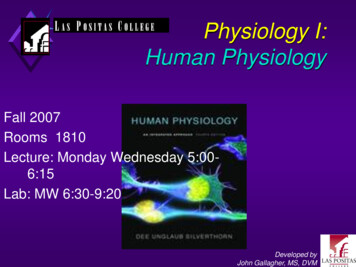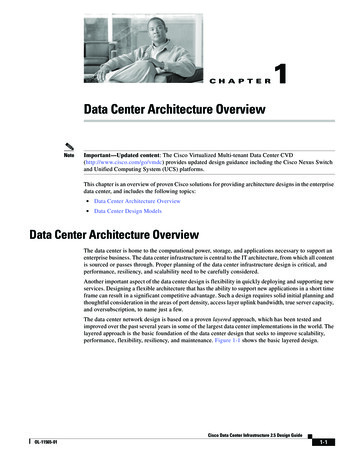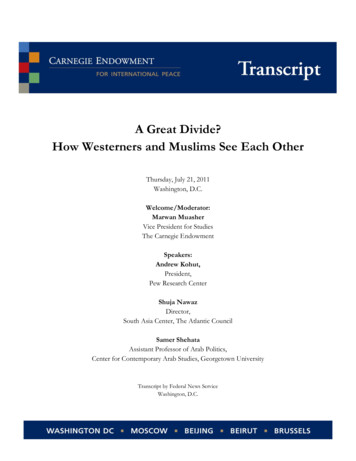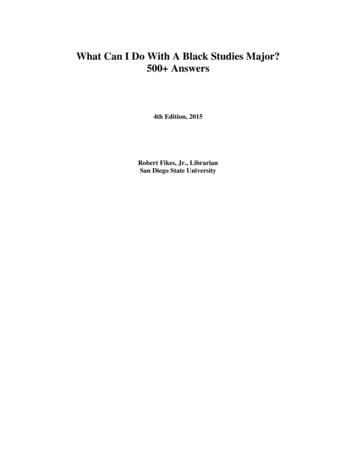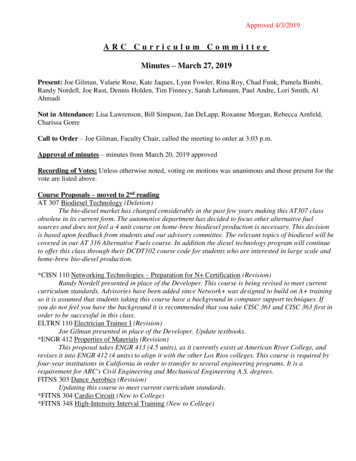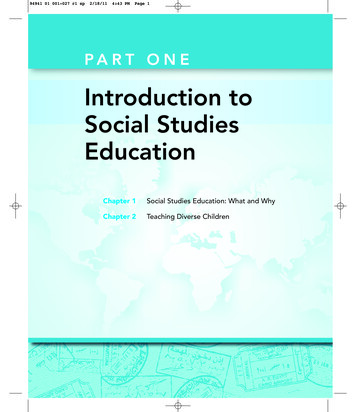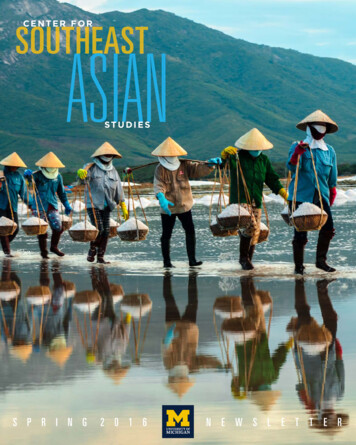
Transcription
CENTER FORSTUDIESS P R I N G2 0 1 6N E W S L E T T E R
Dear CSEAS Community,LETTER FROMTHE DIRECTORThe end of any academic year is a specialtime for many people. We look back notmerely on the variety of events held by thecenter since the fall, but also on the laudableachievements of students, faculty, andstaff. We celebrate our undergraduate, MA,and Ph.D. students who move onto a newchapter of their lives, hoping that SoutheastAsia will always be important to them insome way, and we marvel at the long andillustrious careers of retiring faculty whohave provided happy memories for so many.The second year of our Department ofEducation T6 grant kept us busy, providingfunds to faculty and students for workshopsand research. The noontime lecture serieshad another successful run and wasparticularly well timed for the electionsin Burma/Myanmar this past fall. Ourpartnerships with the School of PublicHealth grew, even while we welcomed newfaculty and doctoral students in fields withwhich we traditionally have enjoyed strongpartnerships, such as anthropology andmusicology.Finally, I am honored to say that I will renewas director of CSEAS for another three-yearterm. It has been a privilege to work with thisdedicated community, and I look forward tomore collaboration in the years ahead.IN THIS ISSUESincerely,Retirement Announcement, CSEAS Lecturer,and 2016 CSEAS MA Graduates 1Christi-Anne CastroCSEAS DirectorAssociate Professor of EthnomusicologyCSEAS Library and Special Collections Fellow 2Award Recipients 32015–2016 CSEAS Events 4ALC Language Fair 5Indigenous Philippine Instruments Workshop 6U-M Graduate Frank Sedlar’s Work in Indonesia 7Student Cultural Nights 10Alumni Updates 12How to Donate 13UNIVERSITY OF MICHIGAN CENTER FOR SOUTHEAST ASIAN STUDIES SPRING 2016
A M E S S A G E F R O M M O N TAT I P K R I S H N A M R A ,T H A I L A N G UAG E L E C T U R E ROn the occasion of her retirement from the Universityof Michigan, we asked Montatip Krishnamra what thefuture holds for her. Though she will be missed verymuch, her positive influence on so many students, both as aneducator and as a person, has had and will continue to havelong-lasting impact.I have been teaching Thai language at theUniversity of Michigan since 1990, and I amretiring this year.My immediate plan after retirement is to produceEnglish books in Braille for the Northern Schoolfor the Blind in Chiang Mai and also for theSouthern School for the Blind in Surat Thani. Thelatter will be in cooperation with my current FLTAKingkan Supornsirisin who introduced me to theschool and, coincidentally, her office is only 3kilometers from the school.I learned Braille when I taught a visually impairedstudent at U-M. I received a grant from U-Mto learn Braille so that I could teach her. As myfamily taught the concept of noblesse obligesince we were very young, I want the knowledgeI gained as a result of the U-M grant to go tofurther use. Therefore, I have decided to extendmy knowledge of Braille to help students inThailand. My first project will be to do the EnglishBraille for Aesop’s Fables, as these are storieswe all learned in Thai as children. This will helpenhance their knowledge of English by usingthe stories they already knew to learn anotherlanguage: English. My hope is that, through thiswork, the legacy of the funding I received fromthe U-M will continue to grow.I will also be picking up the collection of Englishidioms that I have gradually collected over thepast several years to teach Thai students who arelearning to speak English. I have been in initialtalks with Chulalongkorn University Publishingthat have been very encouraging. I am alsofinding some time to do research that will helpCSEAS LECTURERSaul Allen received his PhD from the Department of AsianLanguages and Cultures U-M in 2015. His longstanding interestin Southeast Asia dates to a childhood spent partly in the region.His graduate work culminated in a research project addressed tocontemporary Indonesia and the intersection of popular Islam and culturalpolitics in the post-Suharto era. Alongside work on Indonesia, Saul maintains an active investmentin understanding religion broadly and its political manifestations around the world. His currentproject looks at religion during moments of constitution writing in Indonesia, Lebanon, France, andthe United States. Saul is also a tireless promoter of Southeast Asian studies and travel, as hisstudents would no doubt attest. Saul taught SEAS 215/UC 215 this semester.UNIVERSITY OF MICHIGAN CENTER FOR SOUTHEAST ASIAN STUDIES SPRING 2016me to write a Thai book on an American epic/history that I am really interested in after visitingArizona in 2001 for a U-M funded workshop onteaching foreign languages.C O N G R AT U L AT I O N STO THE CSEAS 2016M A G R A D U AT E S !Zoë McLaughlinZoë’s thesis includes translations of the shortstories Pakarena by Khrisna Pabichara andBintang Jatuh by M. Iksaka Banu as well as ananalysis of these stories. Both stories centeraround the May 1998 riots in Indonesia,and the anti-Chinese nature of theseriots. Pakarena takes a personalapproach to the riots, telling the story oftwo people affected by them. BintangJatuh, on the other hand, uses the1740 massacre of Chinese residentsin Batavia as an allegory for the 1998riots. While differing in approach,both stories deal with the questionof truth in relation to these riots: either personaltruth or a broader truth. Advisor: Nancy FloridaKohlee KennedyAdvisor: Webb KeaneJason TurnerThesis: ‘Highland’ Epics of ‘Lowland’ Ancestry?A State Project of Ethnic Solidarity as Windowto Regional Consciousness.Advisor: John Whitmore1
CSEAS LIBRARY ANDSPECIAL COLLECTIONS FELLOWBy Nguyet NguyenMarch 2016 CSEAS Libraryand Special Collections FellowFounded by the Spanish in 1571, the cityof Manila in the Philippines became acrucial link for the Spanish in the globaltrade during the early modern period. In a shorttime, Manila became a unique model of Spanishcolonial cities in the East. Using Manila as acase study for Spanish colonial urban historyin Southeast Asia, I am working on identifyingthe main characteristics of the formation andtransformation of this metropolitan city. In myresearch, I examine policies, policy planning, andurban management of the colonial period andthe importance of Spanish city planning in theconstruction of Manila. Apart from conventionalmaterials that are fruitful for historical study,I also consider city maps as evidence in thestudy of the urban construction of Manila into aregional and global colonial city.For my research, documents and historical imagesthat are housed at the libraries of the Universityof Michigan about Manila are tremendouslyimportant. Having been awarded the CSEASLibrary and Special Collections Fellowship for themonth of March, I traveled to Ann Arbor whereI was granted access to these rich resources.The Frank T. Corriston photograph collection,which includes pictures of Philippine natives,American troops, battlefield scenes, Filipinoprisoners, executions, and views in and around2Manila, was a relevant resource that helpedto further my research. I worked extensively inthe Hatcher Graduate Library with both Englishand Spanish resources. I also spent a greatdeal of time at the Bentley Historical Library.The Philippines Collection at Bentley includesnumerous original papers related to Philippineshistory during the Spanish-American period,one of which was the collection of Joseph BealSteere (1842-1940). During four years of travel,Steere collected documents about his expeditionto the Philippines in the form of diaries andtravelogues that contain information about thelivelihood of Filipinos and images of Manilaprior to U.S. colonization of the Philippines.The Hubbell Family Papers, also housed at theBentley, provided me with a broader view of thecity’s situation through the eyes of Clarence andWinifred Hubbell. They detailed their lives andactivities in the Philippines from 1907 to 1912.The University of Michigan’s museum collectionsalso supported my research while I was in AnnArbor. There are a significant number of Asianartifacts that provide evidence for a long-lastinghistory between the Philippines in generaland Manila in particular to different regions inSoutheast Asia and to China and Vietnam. Basedon the porcelain collection by Carl Eugen Guthe atthe Ruthven Museum alone, I was able to collectevidence and learn more about the migrationhistory of communities living in Southeast Asia.Being given the opportunity to conduct researchat the U-M libraries and museums was a greathonor. I was able to work with U-M staff,faculty, researchers, and students to further myresearch, and I return to Hanoi with unforgettablememories of Ann Arbor. The opportunity to createa scholarly bridge between Vietnam and U-M issomething that I cherish, and I wish to expressmy profound thanks to CSEAS for the opportunityto conduct research at U-M. nMs. Nguyen Thi Minh Nguyet is a lecturer in theUrban History Department at the College of SocialSciences and Humanities, Vietnam NationalUniversity (VNU), Hanoi. She received an MA in2014 and started her PhD dissertation in 2015 onThe Philippines’ urban history during the Spanishperiod in Her major research interests include Earlymodern Asian-European interactions, Early-modernglobalization and the Philippines integration, andSoutheast Asian Urban History. She has publishedarticles in Southeast Asian Studies Journal, Vietnamand presented at international conferences suchas: Singapore: The 9th Singapore Graduate Forumon Southeast Asian Studies, DAAD InternationalConference: Integrated Modeling of urban Dynamicsand Transport for Ha Noi, among othersUNIVERSITY OF MICHIGAN CENTER FOR SOUTHEAST ASIAN STUDIES SPRING 2016
L A N G U A G E AWA R D SEach year, CSEASlanguage lecturersnominate one personfrom their classes to awardas the best language student.Congratulations to this year’saward recipients, who wererecognized at the CSEASend-of-year celebration onApril 15, 2016.From left to right:Filipino: Christian PanedaChristian is pursuing a bachelor’s degree inbiomolecular science and minoring in Asianlanguages and cultures (Filipino).Indonesian: Ethan MilesEthan is pursuing a bachelor’s degree in politicalscience and history.Thai: Kaitlyn KuderKaitlyn is a student in the College of Literature,Science, and the Arts.Vietnamese: Dustin TranDustin is pursuing a bachelor’s degree inneuroscience.J U D I T H B E C K E R AWA R D F O R O U T S TA N D I N G G R A D U AT ERESEARCH ON SOUTHEAST ASIAIn 2010 the Office of the SeniorVice Provost for Academic Affairsestablished this yearly prize in honorof this distinguished professor ofemerita from the School of Music,Theatre & Dance who has long tiesto the Center for Southeast AsianStudies. The award is 1,000.A self-nominating competition open tograduate students at any level and inany program, students submit eithera completed paper or a description ofresearch they are currently working on,including field notes or other pertinentmaterial.Napong Tao Rugkhapan(Architecture and Urban Planning)received this year’s award for his paper“Planning Chinatown: Vocabulary,Space, and Technopolitics of HistoricPreservation.” nC S E A S PA R T N E R S W I T H G E E OT O S E N D E D U C AT O R S A B R OA DCSEAS is proud to partner with GlobalExploration for Educators Organization(GEEO) again this year to offer a 1,000travel award to help fund one educator’s travel toSoutheast Asia. Congratulations to JeannetteBenner, this year’s award recipient! Currentlya 6th-grade social studies and language artsteacher in Farmington Hills, Jeannette hastraveled the world extensively but is especiallyinterested in exploring Southeast Asia.Three years ago she traveled with GEEOto Thailand, Laos, and Vietnam and this yearshe plans to travel to Bali and Lombok fromJuly 1–14. Jeannette believes that her studentsenjoy learning from her travels, and she works tobring her experiences abroad into the classroomwhenever possible in an effort to help developglobal citizens. In her application for the award,UNIVERSITY OF MICHIGAN CENTER FOR SOUTHEAST ASIAN STUDIES SPRING 2016Jeannette told us that she“tries to light a flame of responsibility for thewhole world in each student, and taking a trip toSoutheast Asia this summer would give me morefuel for that fire.” CSEAS is happy to contributeto providing this fuel with grant money from theU.S. Department of Education. n3
2015–2016 CSEAS EVENTSThis academic year’s guest lecturers, film screenings, and musicalevents garnered strong attendance numbers and enriched ouracademic community.CSEAS Fridays atNoon Lecture SeriesNOVEMBER 13SEPTEMBER 25Merav ShohetProfessor of Anthropology,University of Toronto“Two Deaths and a Funeral: Grief,Moral Affects, and RitualInscriptions in Vietnam”Min ZinPh.D. Candidate, Political Scienceat University of California, Berkeley“Burmese Politics in the Aftermathof 2015 Elections: A Tipping Pointin Civil-Military Relations?”MARCH 11Judith BeckerProfessor Emerita of Ethnomusicology, University of Michigan“Burmese Spirit (nat) Rituals: Trance,Transvestites, and Transcendence”CSEASFilm ScreeningJANUARY 26Don’t Think I’veForgotten: Cambodia’sLost Rock and Roll FilmScreeningCo-sponsored by Sheldon Cohn Fund inthe Department of Screen Arts and Culture,the School of Music, Theatre & Dance, theProfessorof Filipino and Philippine LiteraturCenter for World Performance Studies,Komisyon sa Wikang Filipino under tConsultant,and WCBN-FM.Additional CSEAS EventsAPRIL 1DECEMBER 11OCTOBER 23Gerald SimAssociate Professor of Film Studies,Florida Atlantic University“Postcolonial/Late Capitalist Space:Towards an Understanding ofSingapore Cinema”Alice BaProfessor of Political Science andInternational Relations, Universityof Delaware“Between States and Industry: theNippon Foundation and the Safetyof the Malacca Strait”OCTOBER 29Ruth MabangloProfessor of Filipino and PhilippineLiterature at the University of Hawai’iPoetry Reading and DiscussionFEBRUARY 19Julia CassanitiAssistant Professor at WashingtonState University“The Passage of Time and theCultural Psychology of MentalHealth in Buddhist Thailand”4Adam LifsheyAssociate Professor at GeorgetownUniversity“Subversions of the AmericanCentury: The Surprising Challengesof 20th-Century Filipino Literaturein Spanish”Co-sponsored by the CenteLanguages andAPRIL 15Jeffrey HadlerAssociate Professor at Universityof California, Berkeley“Muslim Memories of BuddhistPasts”FEBRUARY 24Dredge Byung’Chu KangUNIVERSITY OF MICHIGAN CENTER FOR SOUTHEAST ASIAN STUDIES SPRING 2016
Lecture: “Idols of Development:The Performance of AsianModernity via Queer Thai K-PopFandom”Presented by Nam Center for Korean Studies,co-sponsored by CSEASSantosa SoewarlanVisiting InstructorDECEMBER 12 AND MARCH 20Gamelan ConcertsThe ALC Language Fair tookplace February 12, 2016. Thefair provided students withan opportunity to discoverthe Asian language programsavailable at the University ofMichigan. Those who attendedwere also treated to snacks,prizes, and live culturalperformances.2016LANGUAGE FAIRAPRIL 7Pierre-Yves ManguinProfessor Emeritus of Archaeology,Ecole Francaise D’extreme-OrientLecture: “Ships and Shippers ofPre-Modern Southeast Asia: ANeglected Link in Eurasian TradeSystems”Co-sponsored by Center for South AsianStudies, Department of Anthropology,Museum of Anthropological Archaeology,and Doctoral Program in Anthropology andHistoryAPRIL 12Grace NonoTalk-Performance: “DecolonizingVoice”Co-sponsored by Center for WorldPerformance Studies5
INDIGENOUSPHILIPPINEINSTRUMENTSWORKSHOPIn partnership with theFilipino-American StudentAssociation (FASA),Philippine Studies Initiative(PSI), and the PhilippineArts and Culture Ensembleof Michigan (PACE-MI),CSEAS organized a workshopto explore some of thefascinating music and soundsof the Philippines. Theintensive music workshop,entitled “Indigenous PhilippineMusic of the NorthernCordillera Mountain Regionand Southern Philippines: AnIntroduction and Exploration,”took place March 19, 2016.Using the agong, dabakan,and kulintang from ShirleyYengoyan’s ensemble donatedto CSEAS last year by herdaughter Leah Trulik, BernardBarros Ellorin flew to AnnArbor to lead the workshop.Bernard has summarized theworkshop and what it aimedto accomplish here.6On March 19, 2016, I gave a workshop onindigenous Philippine ensemble music atthe International Student Center of theUniversity of Michigan Ann Arbor. Throughthe sponsorship of community-basedand university-based organizations, theintent of the workshop was to provide adeeper understanding of the insider andoutsider perspectives on the indigenousPhilippine ethnic minorities. Two teachingmethodologies and pedagogies were usedto engage attendees to the workshop:1) a powerpoint presentation with fieldworkfootage and music examples; and 2) hands-onparticipation of the regional differences withinthe gangsa (flat gong traditions) of the NorthernLuzon, Philippines and the kulintang (gongchime) traditions from the Muslim minoritiesof the Southern Philippines. As the presenter, Ispecifically presented on these ethnic minoritiesbecause they have been marginalized andmisrepresented by the hegemonic majority ofLowland Filipinos. Therefore, it was importantto include native perspectives on the musicso others will be informed of the theoriesand concepts unique to these regions. For theworkshop, I was satisfied with theoverall outcome because I made myresources accessible to the communityand the university. In some cases ofthe workshop I gave agency to thosedescended from the actual ethnicgroups on their culture; this validatedthe whole purpose of placingimportance on indigenous theory inmy presentation. Workshops as such are neededfor future audiences who have limited exposureto Philippine cultural arts, especially for studentsof Philippine descent who are searching forlegitimate resources on Philippine culture. Insum, this workshop planted the seed for uniqueapproaches to engaging students on campus andthe community at large. nBernard Barros Ellorin received hisPhD in Ethnomusicology from the Universityof Hawai‘i at Manoa last December 2015. Hisresearch interest is on traditional ensemblemusic from the northern and southernPhilippines. Ellorin has studied with variousmaster artists of kulintang(an) gong-chimemusic from Mindanao and Sulu Archipelago,Philippines; he also has experience in learningtraditional Kalingga and BIBAK Cordillera gangsamusic from northern Luzon at UP Diliman andwith Bibak organizations in Southern California.UNIVERSITY OF MICHIGAN CENTER FOR SOUTHEAST ASIAN STUDIES SPRING 2016
A STROKEOF LUCKTWITTERANDSENSORSH O W A U - M G R A D U AT EI S TA C K L I N G F L O O DM I T I G AT I O N I N J A K A R TABy Nayiri Mullinix Photographs by Marcin SzczepanskiIt was by chance that Frank Sedlar walked through the TaubmanCollege of Architecture and Urban Planning in the spring of 2013and spotted a flyer announcing a project called “Architecture Adaptation: Designing for Hypercomplexity.” This phase of the project,the flyer announced, would take place in Jakarta, Indonesia, and wouldbe led by then University of Michigan College of Architecture Fellow andCenter for Southeast Asian Studies (CSEAS) Research Affiliate EtienneTurpin and U-M College of Architecture Professor Meredith Miller. Frankhad just obtained his Bachelor of Engineering degree and, as a buddingcivil engineer conducting independent research on flooding, the flyerintrigued him. Not entirely confident that an engineer would be invited tojoin the project, Frank reached out to Etienne to explore the possibility.Two weeks later, Frank was on a plane to Jakarta.The trip he took to Indonesia with Etienne and Meredith in 2013 wasFrank’s first visit to Southeast Asia. At the time he knew very littleabout the region, and his mother was sure to remind him that he wouldbe very, very far away from his hometown in the Upper Peninsula ofMichigan. Though the first trip didn’t necessarily allow him to get acomprehensive taste for the culture of Indonesia, Frank did make ameaningful connection to the city of Jakarta. Perhaps most importantly,that first visit enabled him to discover that the flooding issues facing thecity were directly related to the work he was interested in pursuing as acivil engineer.As one of approximately thirty megacities in the world, Jakarta hasbeen facing rapid urbanization. The number of megacities, defined ascities with populations that exceed ten million, is on the rise worldwidedue to trends that show steady increases in movement to cities fromrural areas. Most megacities are similar to Jakarta in that they arecoastal cities in developing countries. The burden that such rapid growthUNIVERSITY OF MICHIGAN CENTER FOR SOUTHEAST ASIAN STUDIES SPRING 20167
Sedlar’s FulbrightFellowship focuses onidentifying areas ofJakarta that are mostvulnerable to floodingand then building andinstalling computerbased sensors tomeasure water levelsin order to predictfuture floods.places on existing infrastructure, infrastructure that was never intendedto accommodate so many millions of people, is significant. Jakarta, a citythat has been sinking in places at a rate of two meters per year, has a seawall separating it from the Java Sea that consists of a mere several feet ofconcrete. Needless to say, the city floods often. In recent years, the floodinghas been so severe that people have been forced to abandon homes andneighborhoods. Jakarta’s plight indicates a clear need for solutions and whenone factors in climate change and the estimated resulting sea-level rise ofabout 3 mm per year, the need becomes even more apparent.When Frank started his work in Jakarta, the government was beginning toexplore the possibility of building a 40-billion-dollar sea wall to protect thecity from flooding. As a civil engineer, however, Frank wanted to explore thepossibility of working with the existing infrastructure to see if it could bemanaged more effectively. He began by seeking existing flood data and, tohis surprise, discovered that very little data had been collected.After four weeks in Jakarta with Etienne and Meredith in 2013, Frankreturned to Ann Arbor inspired to find a way to continue to work in Jakarta.He quickly discovered that U-M is one of a handful of universities in the U.S.that offers Indonesian language courses so, as he pursued his MS in Civil8Engineering, Frank decided to enroll in Bahasa Indonesian. He worked withhis language instructors, Agustini and Nancy Florida, whom he credits formuch of his progress in Indonesia, and received a Foreign Language and AreaStudies Fellowship (FLAS) through CSEAS as his commitment to Indonesianlanguage acquisition became more focused.At the same time as Frank was working toward his MS in Ann Arbor, Etienne,now a research fellow at the University of Wollongong in Australia, began aresearch project named Peta Jakarta. The project was founded on the ideathat the citizens of Jakarta could provide a great deal of assistance with thecollection of real-time flood information via social media. In partnership withthe government of Jakarta and Twitter, Peta Jakarta has developed a methodof data collection that works efficiently in a country with one of the mostsocial media savvy populations in the world. The governor of Jakarta, BasukiTjahaja Purnama, sent the very first project-related tweet on December 2,2014. In it, he encouraged the people of Jakarta to tweet @petajkt aboutflooding and to report where it was occurring. Now in its second year, PetaJakarta has received and verified millions of tweets.Given the availability of high-quality data as a result of Peta Jakarta’ssuccess and having completed his MS in Civil Engineering, Frank wroteUNIVERSITY OF MICHIGAN CENTER FOR SOUTHEAST ASIAN STUDIES SPRING 2016
a Fulbright proposal that would enable him to continue to work towardexploring new ways of operating existing infrastructure more efficiently. Hewas awarded a Fulbright Fellowship and moved to Jakarta in December 2015to begin his work. Currently underway, his project focuses on identifyingareas of Jakarta that are most vulnerable to flooding and then building andinstalling computer-based sensors to measure water levels in order to betterpredict when a flood might occur. Frank will be working on this project throughSeptember 2016, during which time Frank hopes to install multiple sensors toenhance his work with flood data collection, calculation, and modeling.UNIVERSITY OF MICHIGAN CENTER FOR SOUTHEAST ASIAN STUDIESAfter living in Jakarta for the past five months, Frank has had the opportunityto build relationships with the locals and to get an overall sense for theculture. He’s found that the people of Indonesia tend to be conservative butare also friendly, open, hospitable, and easy to work with, particularly afterconsuming a few cups of numbingly sweet coffee. Initially, Frank hadn’tconsidered staying in Jakarta upon completing his Fulbright project. Theprospect of working with a local engineering firm and spear-heading the wayin which flooding will be handled globally in future years, however, has lefthim reconsidering the possibility. n SPRING 20169
Pho NightÐêm Viêt NamThai NightPho Night is an event that the VietnameseStudent Association holds once a semesterat Trotter Multicultural Center. This year, PhoNight took place in November and in April. Thegoal of Pho Night is to showcase a traditionalVietnamese delicacy to the University ofMichigan community. VSA board members spendtwo days preparing the dish, comprised of abeef noodle broth, noodles, and other garnishes.By bringing the community together for a nightof enjoying a hot, tasty dish, the VSA hopesto diversify people’s experiences on campusby introducing them to a traditional dish thatis a hallmark of Vietnamese culture. Proceedsfrom Pho Night go to charity. This year, theVSA donated funds to the Union of VietnameseStudent Associations of the Midwest’s charity,Kids Without Borders, and the American CancerSociety for MRelay.Đêm Viêt Nam is the Vietnamese StudentAssociation’s largest event of the year. It displaysthe effect that two cultures, Vietnamese andAmerican, have on University of Michigan students,which is then expressed in artistic fashion. Over120 performers dance in traditional and modernform, sing, and perform instrumental acts. Theperformance, which has a yearly audience of over500 people, was sold out this year. The themefor this year’s show was Once Upon A Time:NGÀY XỬA NGÀY XƯA. The traditional andmodern dances that were performed wereintended to showcase Vietnamese cultureto the university community. All proceedsfrom DVN are donated to charity. This year,proceeds went to the Vietnam FriendshipVillage Project USA, a facility located in Hanoi,Vietnam that provides medical care, physicaltherapy, educational and vocational trainingto Vietnamese children, young adults, andveterans with various impairments.Each year, the Thai Student Association (TSA)at the University of Michigan organizes a culturalevent to promote the unique culture of Thailandon campus. This year the event took place onApril 3, 2016 at East Hall and attracted more than300 guests who enjoyed delicious food and avariety of performances.10UNIVERSITY OF MICHIGAN CENTER FOR SOUTHEAST ASIAN STUDIES SPRING 2016
MalaysianCultural NightThe Malaysian Cultural Night took placeMarch 28, 2016 at the Mendelssohn Theater.The evening started off with a speech fromthe President of the Michigan MalaysianStudents Association. Miss Ili Nazurah followedwith another speech and a short backgroundexplanation of the play being performed thatevening by the director of the Malaysian CulturalNight, Mr. Zaryff Razali. The audience alsoenjoyed a variety of dance performances thatcomplemented the play. The dance performancesincluded a Chinese Fan Dance, Lion Dance, Zapin,Tarian Buluh, and a Bollywood Dance. After theplay, the audience moved to the Chemistry Atriumto indulge in a variety of Malaysian Cuisines. Theattendees were treated to Mee Goreng, SatayAyam, Bingka Ubi and a Malaysian favourite, icedMilo. About 500 people were in attendance.SEA GamesOn October 4, 2015, the Singaporean, Thai,Malaysian and Indonesian Students’ Associationsorganized and participated in the annual SEAGames. It was a day of fun, games, laughter, andinter-association bonding. Through the course ofthe event, participants got to know students fromother parts of Asia, their culture and customs,and a few words in other languages. SEA Nightwas held that same evening and offered theopportunity to mingle and get to know oneanother. Highlights of the evening includeda trivia game based on SEA history, culture,media and geography, and the traditionalSingaporean and Malaysian food that wasserved to attendees.UNIVERSITY OF MICHIGAN CENTER FOR SOUTHEAST ASIAN STUDIES SPRING 2016IndonesianCultural NightPERMIAS (Indonesian Student Association)hosted the annual Indonesian Cultural Nightevent on February 20, 2016 at Angell Hall.The annual event aims to introduce the U-Mcommunity to authentic Indonesian culture. Thisyear’s event featured the U-M Javanese GamelanEnsemble, traditional Indonesian dances, and adrama performance based on Indonesian folklore.Guests were also treated to Indonesian entreesand drinks while they explored informationalbooths with traditional clothing, snacks, andmusical instruments.11
Ken HallALUMNIUPDATESAndrew ShepardAndrew Shepard (JD, 2008) is a Foreign ServiceOfficer, most recently serving in the Environment,Science, Technology, & Health unit at the U.S.Embassy in Hanoi, Vietnam. He managedbilateral and regional cooperation on a rangeof issues, including wildlife trafficking, climatechange, air pollution, civil-nuclear cooperation,emerging pandemic threats, science education,space partnerships, and dioxin remediation,among others. He is currently in languagetraining and w
The Hubbell Family Papers, also housed at the Bentley, provided me with a broader view of the city’s situation through the eyes of Clarence and Winifred Hubbell. They detailed their lives and activities in the Philippines from 1907 to 1912. The University of Michigan’s museum collect



